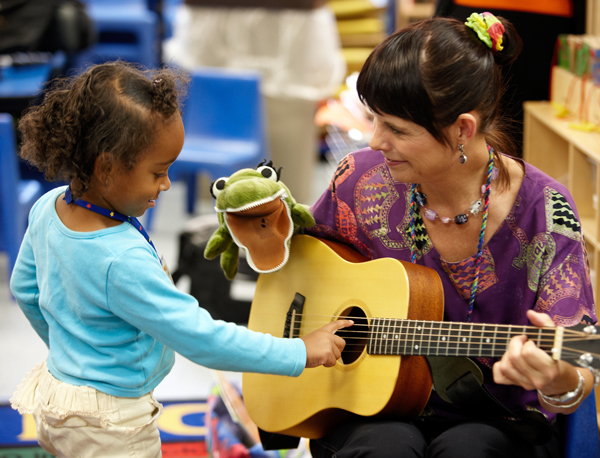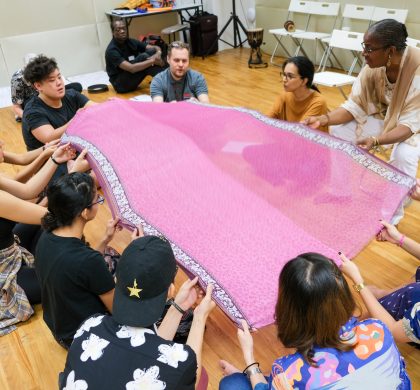Three Arts Strategies For Incorporating Social-Emotional Learning Into Your Classroom

Oct 04, 2021
What does it mean to “meet students where they are”? In 2017, the Aurora Institute released a series of briefs1 that championed this concept, in which it called upon educators to look at students from a more holistic perspective: students could not truly thrive if they were academically competent, but were struggling in other areas, Aurora Institute advised. Teachers needed to gauge where their students are cognitively, culturally, emotionally, physically, and behaviorally, in addition to academically.
Given the challenges teachers, students, and families have faced over the past 18 months, it is more important than ever to take these factors into account, and the practice of social-emotional learning [SEL] has become an important way to help educators ease themselves, their students, and their families back into the traditional classroom environment.
“Social-emotional learning provides students with the skills they need to manage their emotions, show empathy toward others, and build resiliency,” says Jennifer Edelen, director of Wolf Trap Institute for Early Learning Through the Arts. “The arts are a safe place through which children can express themselves, and when incorporated into SEL, are a wonderful avenue toward achieving positive experiences for students.”
The practice of SEL has grown exponentially over the past several years, and especially throughout the pandemic. Wolf Trap Teaching Artists have drawn on their skills in the art of teaching dance, music, drama, and puppetry to provide early childhood educators with professional development and arts strategies that encourage students to express their emotions.

Here are some SEL-centered arts strategies that educators can easily incorporate into their classroom learning:
Movement: “Pass the Dance”
“Children thrive when they are able to expand and grow in holistic ways,” says Wolf Trap Master Teaching Artist Valerie Branch. One strategy Branch shares with early childhood educators is “pass the dance.” To use this strategy, gather students in a circle and begin the exercise with a movement, indicative of your mood. Ask the student sitting next to you to choose their own movement and pass it on [to the next child], until “the dance” returns to the leader. Some students may not want to participate at first, and that’s okay—they can simply “pass the dance” on to the next student. Repeat the movement at least twice so that students who declined to participate the first time have the chance to do so the second time, if they choose.
Drama: “Back Pocket Masks”
Wolf Trap Master Teaching Artist Paige Hernandez developed a strategy for exploring emotions called “Back Pocket Masks.” Through this technique, Hernandez advises teachers to have children pull out invisible masks from their pockets to illustrate their feelings. “What do you look like when you’re happy,” she asks. “How about when you’re sad?”
Song: “I’ve Got a Feeling (Down in My Toes)”
Create a song that helps students vocalize and express their feelings. Remember, feelings are important to acknowledge, even if they’re not always positive. This past year, Wolf Trap Teaching Artist Elias Schutzman collaborated with fellow Wolf Trap Master Teaching Artist Kofi Dennis on an original song that encouraged children to express their emotions. “I’ve Got a Feeling (Down in My Toes)” uses a catchy tune to explore a range of emotions: Schutzman begins with feeling “happy,” then transitions to “sad,” and “scared,” before ending the song with an expression of “love.” With each verse, he encourages children to match their facial expression to─or act out─the emotion. The intention is for children to express themselves constructively, recognize the value of each emotion, and create a safe space for them where all feelings are valid and acceptable.
Bonus: Use Books as a Conversation Starter
Children’s books are a wonderful beginning point for talking about emotions. Many of Wolf Trap’s Teaching Artists use one or two pages as an introduction to launch into an arts exercise. Below are some suggestions tailored to Early Education classrooms:
- Bang, Molly. When Sophie’s Feelings are Really, Really Hurt. The Blue Sky Press, 2015.
- Cain, Janan. The Way I Feel. Parenting Press, Inc, 2002.
- Doerrfield, Cori. The Rabbit Listened. Dial Books, 2018.
- Emberley, Ed and Anne Miranda. Glad Monster, Sad Monster. LB Kids, 1997.
- Parr, Todd. The Feelings Book. LB Kids, 2005
Whether virtual learning, or in-person, SEL strategies hold deep value for teachers and students, and they are here to stay.
“Strong SEL skills are directly correlated to academic achievement and are critical for long term success later in life,” says Edelen. “Together, the arts and SEL promote the kind of positive attitudes and behaviors that are essential for us, as a community, as we move forward.”
For more arts-integration strategies, visit education.wolftrap.org.
###1Rudenstine, Antonia, Schaef, Sydney and Bacallao, Dixie. “What Does It Mean to Meet Students Where They Are?” COMPETENCYWORKS Blog. June 15, 2017. https://aurora-institute.org/cw_post/what-does-it-mean-to-meet-students-where-they-are/
Recommended Posts

Cultivating Education Rockstars
Oct 24, 2024 - Education


